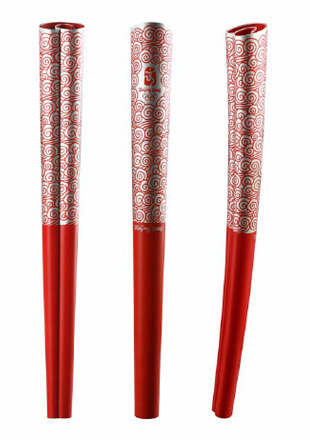
The Key Facts about the Torch
The torch is 72 centimetres high, weighs 985 grams and is made of aluminium. The torch is of a curved surface form, with etching and anodizing being used during its production. A torch can usually keep burning for approximately 15 minutes in conditions where the flame is 25 to 30 centimetres high in a windless environment. The torch has been produced to withstand winds of up to 65 kilometres per hour and to stay alight in rain up to 50mm an hour. The flame can be identified and photographed in sunshine and areas of extreme brightness. The fuel is propane which is in accordance with environmental guidelines. The material of its form is recyclable.
The Artistic and Technical Features of the Torch
The torch of the Beijing Olympic Games has a very strong Chinese flavour. It demonstrates the artistic and technical level of China. It also conveys the message of a Green Olympics, a High-tech Olympics and the People's Olympics. The shape of the paper scroll and the lucky clouds graphic, expresses the idea of harmony. Its stable burning technique and adaptability to the environment have reached a new technical level. The torch of the Beijing Olympic Games is designed, researched and produced in China. BOCOG owns all intellectual property rights.
The Fuel for the Torch
Under the concept of a Green Olympics, environmental protection was a key element listed in the invitation documents to the design companies, by BOCOG. The fuel of the torch is propane, which is a common fuel which also comes with a low price. It is composed of carbon and hydrogen. No material, except carbon dioxide and water remain after the burning, eliminating any risk of pollution.
The Burning System
The burning system of the torch is designed by China Aerospace Science & Industry Corporation. Its stable burning technique and adaptability to the environment have reached a new technical level. It can stay alight in severe weather conditions such as strong wind, rain, snow, hail, etc. The flame can also be identified in sunshine and areas of extreme brightness so as to satisfy the requirements of capturing photographic images and video footage.
The Design Timelines
2005 August BOCOG developed the design concepts and requirements of the torch.
2005 December BOCOG recruited potential torch designs from the design society. In total, BOCOG received 388 pieces of works.
2006 June-August BOCOG selected the structural designer and the burning system designer.
2007 January Beijing Olympic Torch was approved by IOC
'중국story' 카테고리의 다른 글
| 베이징올림픽 마스코트 (Mascots of the Beijing 2008 Olympic Games) (1) | 2008.08.08 |
|---|---|
| 베이징 올림픽 메달 (Design of the Medal for the Beijing 2008 Olympic Games) (0) | 2008.08.08 |
| 중국의 인공강우(비) (2) | 2008.07.17 |
| 유승준, 청룡 한솥밥 먹네 (1) | 2008.07.14 |
| 베이징올림픽 공식축구공 만리장성의 별... (0) | 2008.07.13 |



